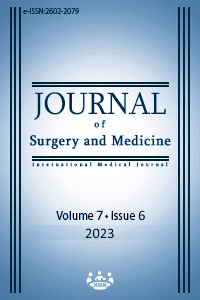Efficacy of Taraxacum officinale in liver damage caused by doxorubicin in rats
Taraxacum and doxorubicin-induced liver toxicity
Keywords:
Doxorubicin, toxicity, Taraxacum officinale, rat, liverAbstract
Background/Aim: The use of doxorubicin is limited due to its toxic effects on normal cells. A substance containing antioxidant properties, such as taraxacum officinale, would be useful in preventing doxorubicin toxicity. This study aimed to evaluate the effect of taraxacum officinale on doxorubicin-induced damage in the rat liver.
Methods: Forty Wistar albino rats were allocated into four groups. In group 1 (control group), no treatment was given. In group 2 (Taraxacum officinale, group T), 100 mg/kg Taraxacum officinale was administered via the gavage route for 10 days. In group 3 (doxorubicin, group D), a single intraperitoneal dose of 40 mg/kg doxorubicin was given. In group 4 (doxorubicin + Taraxacum officinale, group D+T), a single intraperitoneal dose of 40 mg/kg doxorubicin was administered on the eighth day, and 100 mg/kg Taraxacum officinale was administered for 10 days. Blood malondialdehyde (MDA) levels and the activities of catalase (CAT) and superoxide dismutase (SOD) were measured. Histopathology was assessed by examining preparations of hepatic tissue with light microscopy and immunohistochemistry.
Results: MDA levels were significantly higher, and the activities of SOD and CAT were lower in group D than in group D+T (P=0.04). Tissue damage was significantly higher in group D than in group D+T (P=0.03).
Conclusion: Our short-term results indicate that oxidative stress could be responsible for the damage to liver tissue due to doxorubicin, and Taraxacum officinale might reverse these harmful effects.
Downloads
References
Nam J, Son S, Ochyl LJ, Kuai R, Schwendeman A, Moon JJ. Chemo-photothermal therapy combination elicits anti-tumor immunity against advanced metastatic cancer. Nat Commun. 2018;9:1074. DOI: https://doi.org/10.1038/s41467-018-03473-9
Roychoudhury S, Kumar A, Bhatkar D, Sharma NK. Molecular avenues in targeted doxorubicin cancer therapy. Future Oncol. 2020;16:687-700. DOI: https://doi.org/10.2217/fon-2019-0458
Johnson PJ, Dobbs N, Kalayci C, Aldous MC, Harper P, Metivier EM, et al. Clinical efficacy and toxicity of standard dose adriamycin in hyperbilirubinaemic patients with hepatocellular carcinoma: relation to liver tests and pharmacokinetic parameters. Br J Cancer. 1992;65:751. DOI: https://doi.org/10.1038/bjc.1992.158
Thorn CF, Oshiro C, Marsh S, Hernandez-Boussard T, McLeod H, Klein TE, et al. Doxorubicin pathways: Pharmacodynamics and adverse effects. Pharm Genom. 2011;21:440-6. DOI: https://doi.org/10.1097/FPC.0b013e32833ffb56
Pfitzer L, Moser C, Gegenfurtner F, Arner A, Foerster F, Atzberger C, et al. Targeting actin inhibits repair of doxorubicin-induced DNA damage: A novel therapeutic approach for combination therapy. Cell Death Dis. 2019;10:1546-9. DOI: https://doi.org/10.1038/s41419-019-1546-9
Wang Y, Mei X, Yuan J, Lu W, Li B, Xu D. Taurine zinc solid dispersions attenuate doxorubicin-induced hepatotoxicity and cardiotoxicity in rats. Toxicol Appl Pharmacol. 2015;289:1-11. DOI: https://doi.org/10.1016/j.taap.2015.08.017
Barakat BM, Ahmed HI, Bahr HI, Elbahaie AM. Protective Effect of Boswellic Acids against Doxorubicin-Induced Hepatotoxicity: Impact on Nrf2/HO-1 Defense Pathway. Oxid Med Cell Longev. 2018;8296451. DOI: https://doi.org/10.1155/2018/8296451
Nagai K, Oda A, Konishi H. Theanine prevents doxorubicin-induced acute hepatotoxicity by reducing intrinsic apoptotic response. Food Chem Toxicol. 2015;78:147-52. DOI: https://doi.org/10.1016/j.fct.2015.02.009
Sun AS, Ostadal O, Ryznar V, Dulik I, Dusek J, Vaclavik A, et al. Phase I/II study of stage III and IV non-small cell lung cancer patients taking a specific dietary supplement. Nutr Cancer. 1999;34:62-9. DOI: https://doi.org/10.1207/S15327914NC340109
Schütz K, Carle R, Schieber A. Taraxacum-a review on its phytochemical and pharmacological profile. J Ethnopharmacol. 2006;107:313-23. DOI: https://doi.org/10.1016/j.jep.2006.07.021
Diaz K, Espinoza L, Madrid A, Pizarro L, Chamy R. Isolation and identification of compounds from bioactive extracts of Taraxacum officinale (Dandelion) as a potential source of antibacterial agents. Evidence Based Complementary and Alternative Medicine 2018;2706417:1-8. DOI: https://doi.org/10.1155/2018/2706417
Ohkawa H, Ohishi N, Yagi K. Assay for lipid peroxides in animal tissues by thiobarbituric acid rection. Anal Biochem. 1979;95:351-8. DOI: https://doi.org/10.1016/0003-2697(79)90738-3
Marklund S, Marklund G. Involvement of superoxide anion radical in the autoxidation of pyrogallol and a convenient assay for superoxide dismutase. Eur J Biochem. 1974;47:469-74. DOI: https://doi.org/10.1111/j.1432-1033.1974.tb03714.x
Aebi H. Catalase in vitro. Methods Enzymol. 1984;105:121-6. DOI: https://doi.org/10.1016/S0076-6879(84)05016-3
Rivankar S. An overview of doxorubicin formulations in cancer therapy. J Cancer Res Ther. 2014;10:853-8. DOI: https://doi.org/10.4103/0973-1482.139267
Bilgic S, Ozgocmen M. The protective effect of misoprostol against doxorubicin induced liver injury. Biotech Histochem. 2019;94:583-91. DOI: https://doi.org/10.1080/10520295.2019.1605457
Prasanna PL, Renu K, Gopalakrishnan AV. New molecular and biochemical insights of doxorubicin-induced hepatotoxicity. Life Sci. 2020;250:117599. DOI: https://doi.org/10.1016/j.lfs.2020.117599
Wang M, Zhang X, Xiong X, Yang Z, Li P, Wang J, et al. Bone Marrow Mesenchymal Stem Cells Reverse Liver Damage in a Carbon Tetrachloride-induced Mouse Model of Chronic Liver Injury. In Vivo. 2016;30:187-93.
Ren YS, Zheng Y, Duan H, Lei L, Deng X, Liu XQ. Dandelion polyphenols protect against acetaminophen-induced hepatotoxicity in mice via activation of the Nrf-2/HO-1 pathway and inhibition of the JNK signaling pathway. Chin J Nat Med. 2020;18:103-13. DOI: https://doi.org/10.1016/S1875-5364(20)30011-X
Liu Q, Chen Y, Shen C, Xiao Y, Wang Y, Liu Z. Chicoric acid supplementation prevents systemic inflammation-induced memory impairment and amyloidogenesis via inhibition of NF-κB. FASEB J. 2017;31:1494-507. DOI: https://doi.org/10.1096/fj.201601071R
Im DY, Lee KI. Antioxidative and antibacterial activity and tyrosinase inhibitory activity of the extract and fractions from Taraxacum coreanum Nakai. Korean J Med Crop Sci. 2011;19:238-45. DOI: https://doi.org/10.7783/KJMCS.2011.19.4.238
Park MS, So JS, Bahk GJ. Antioxidative and anticancer activities of water extracts from different parts of Taraxacum coreanum Nakai cultivated in Korea. J Korean Soc Food Sci Nutr. 2015;44:1234-40. DOI: https://doi.org/10.3746/jkfn.2015.44.8.1234
Downloads
- 440 804
Published
Issue
Section
How to Cite
License
Copyright (c) 2023 Özlem Kara, Asuman Kilitçi
This work is licensed under a Creative Commons Attribution-NonCommercial-NoDerivatives 4.0 International License.
















